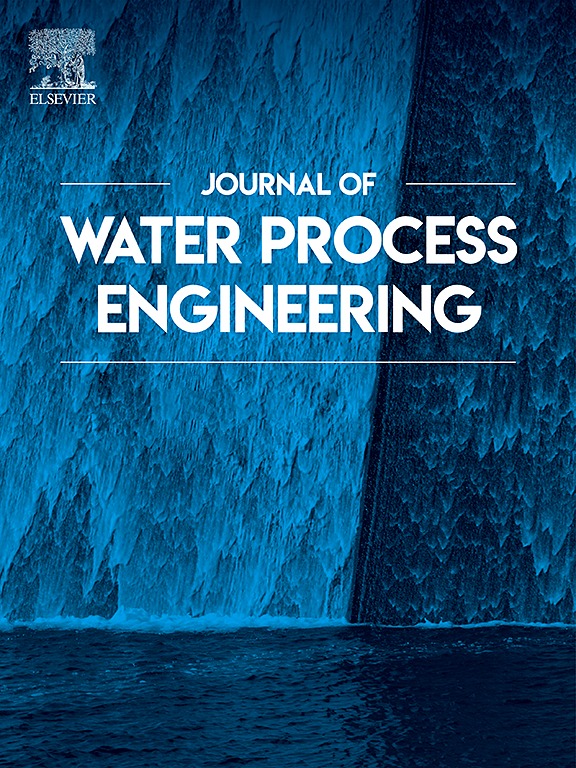Hydrazine-mediated control of denitrifiers overgrowth: Dual mechanisms for suppressing denitrifiers while stimulating anammox bacteria in anammox-denitrification systems
IF 6.7
2区 工程技术
Q1 ENGINEERING, CHEMICAL
引用次数: 0
Abstract
In simultaneous anammox-denitrification (SAD) systems, the overgrowth of denitrification bacteria severely impairs nitrogen removal efficiency by competing with anammox bacteria for nitrite under organic-rich conditions. In this study, we propose a hydrazine (N2H4)-based strategy to selectively inhibit denitrification bacteria while stimulating the anammox activity. Batch experiments revealed a concentration-dependent dual role of N2H4: at 10 mg N/L, the anammox activity increased to 123 % of the baseline performance, whereas denitrification activity declined to 59 %. Higher concentrations (≥50 mg N/L) progressively suppressed both anammox and denitrification processes. A dual inhibitory mechanism for N2H4 was proposed: (1) disrupting electron carriers (e.g., cytochrome c) and (2) inactivating key metabolic enzymes like hydrazine dehydrogenase (HDH) or nitrate reductase (Nar). In SAD systems, short-term (5 h) exposure to 10 mg N/L N2H4 effectively curtailed denitrifier overgrowth, elevating the ammonium removal rate from 96.2 ± 0.3 to 116.4 ± 2.5 mg N/g VSS·d, and reducing COD degradation rates from 345.5 ± 13.0 to 268.0 ± 9.7 mg N/g VSS·d. However, the total nitrogen (TN) removal efficiency and the proportional contribution of anammox to TN removal remained suboptimal compared to the control, suggesting that future studies should explore either higher concentrations or extended exposure durations of N2H4 shock to achieve optimal performance. These findings highlight the dual role of N2H4 in modulating microbial competition and propose its application as a control agent to optimize the SAD performance under the organic stress.

肼介导的反硝化菌过度生长的控制:抑制反硝化菌的双重机制,同时刺激厌氧氨氧化-反硝化系统中的厌氧氨氧化细菌
在厌氧氨氧化-反硝化(SAD)同步系统中,在富有机质条件下,反硝化细菌的过度生长与厌氧氨氧化细菌竞争亚硝酸盐,严重影响了氮的去除效率。在这项研究中,我们提出了一种基于肼(N2H4)的策略来选择性地抑制反硝化细菌,同时刺激厌氧氨氧化活性。批量实验揭示了N2H4的浓度依赖性双重作用:在10 mg N/L时,厌氧氨氧化活性增加到基线性能的123%,而反硝化活性下降到59%。较高的浓度(≥50 mg N/L)逐渐抑制厌氧氨氧化和反硝化过程。提出了N2H4的双重抑制机制:(1)破坏电子载体(如细胞色素c)和(2)失活肼脱氢酶(HDH)或硝酸还原酶(Nar)等关键代谢酶。在SAD系统中,短期(5 h)暴露于10 mg N/L N2H4中可以有效抑制反硝化菌的过度生长,将氨的去除率从96.2±0.3 mg N/g VSS·d提高到116.4±2.5 mg N/g VSS·d,将COD的降解率从345.5±13.0降低到268.0±9.7 mg N/g VSS·d。然而,与对照组相比,总氮(TN)去除效率和厌氧氨氧化对TN去除的比例贡献仍然不是最佳的,这表明未来的研究应该探索更高浓度或延长N2H4冲击的暴露时间,以达到最佳性能。这些发现强调了N2H4在调节微生物竞争中的双重作用,并建议将其作为控制剂来优化有机胁迫下SAD的性能。
本文章由计算机程序翻译,如有差异,请以英文原文为准。
求助全文
约1分钟内获得全文
求助全文
来源期刊

Journal of water process engineering
Biochemistry, Genetics and Molecular Biology-Biotechnology
CiteScore
10.70
自引率
8.60%
发文量
846
审稿时长
24 days
期刊介绍:
The Journal of Water Process Engineering aims to publish refereed, high-quality research papers with significant novelty and impact in all areas of the engineering of water and wastewater processing . Papers on advanced and novel treatment processes and technologies are particularly welcome. The Journal considers papers in areas such as nanotechnology and biotechnology applications in water, novel oxidation and separation processes, membrane processes (except those for desalination) , catalytic processes for the removal of water contaminants, sustainable processes, water reuse and recycling, water use and wastewater minimization, integrated/hybrid technology, process modeling of water treatment and novel treatment processes. Submissions on the subject of adsorbents, including standard measurements of adsorption kinetics and equilibrium will only be considered if there is a genuine case for novelty and contribution, for example highly novel, sustainable adsorbents and their use: papers on activated carbon-type materials derived from natural matter, or surfactant-modified clays and related minerals, would not fulfil this criterion. The Journal particularly welcomes contributions involving environmentally, economically and socially sustainable technology for water treatment, including those which are energy-efficient, with minimal or no chemical consumption, and capable of water recycling and reuse that minimizes the direct disposal of wastewater to the aquatic environment. Papers that describe novel ideas for solving issues related to water quality and availability are also welcome, as are those that show the transfer of techniques from other disciplines. The Journal will consider papers dealing with processes for various water matrices including drinking water (except desalination), domestic, urban and industrial wastewaters, in addition to their residues. It is expected that the journal will be of particular relevance to chemical and process engineers working in the field. The Journal welcomes Full Text papers, Short Communications, State-of-the-Art Reviews and Letters to Editors and Case Studies
 求助内容:
求助内容: 应助结果提醒方式:
应助结果提醒方式:


